Established 2002
Lucinda Shepherd, friend Robert Randell and various experts for their support.
Fossil Hunting Tools & Equipment
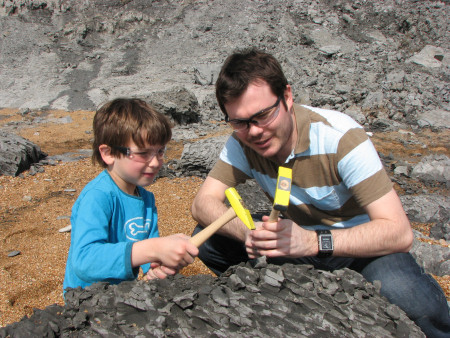
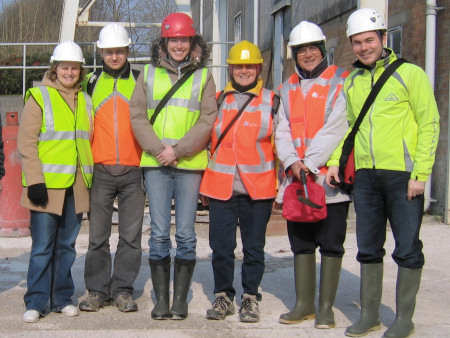
Left: Roy and Louis hammer a boulder in search of fossils at Seatown. Right: From left: Dee, Robert, Lu, Cornelia, Brian and Roy dressed for a quarry.
Fossil hunting can vary from a tranquil stroll on a beach in shorts and t-shirt during the summer, to extreme physical challenges in the depths of winter. As well as recognising the need to dress appropriately, it's worth spending some time planning the tools needed to assist you during the trip. The following page has been prepared to share some general advice for effective and safe fossil hunting.

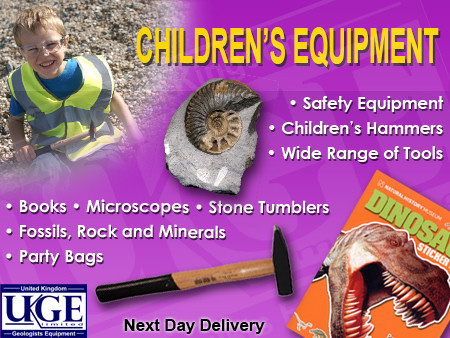
ADVERTISEMENT BY UKGE - OFFICIAL ADVERTISING PARTNER OF DISCOVERING FOSSILS
Hard hat and high visibility jacket
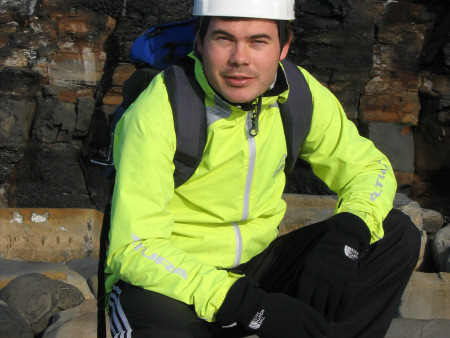
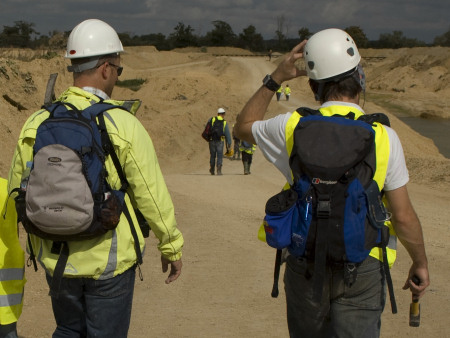
Left: A brightly
coloured coat and hard hat are a good idea in cliff areas on the
coast. Right: A hard hat and high visibility
jacket are a requirement in quarries.
Hard hat: One of the most essential items of safety equipment is a well fitted, quality hard hat. A standard builder's hard hat is the minimum that should be worn in areas that are liable to falling rocks, especially cliff faces and within quarries. The example worn above-left is a climbers hard hat, engineered with practicality in mind.
High visibility jacket: The use of a high visibility jacket or brightly coloured clothing is recommended to improve your chances of being quickly found if an accident were to unfortunately take place. Within quarries their use is a legal requirement as they increase your visibility to vehicle operators in particular. Among the most suitable jackets include those intended originally for cyclists (as shown), these usually incorporate high visibility features and protect from the wind.
A strong bag and walking boots
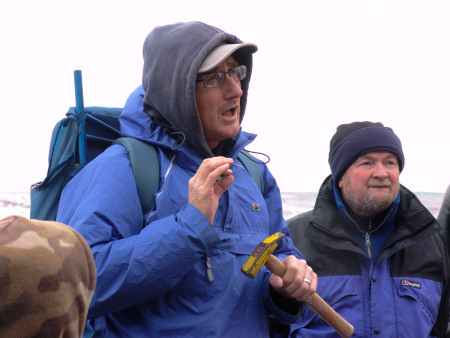
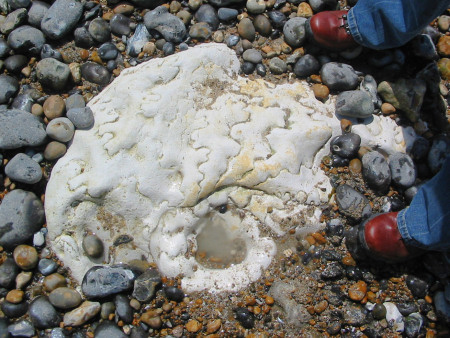
Left: A large strong
bag are best suited for carrying tools and fossils. Right: Walking boots are generally
the best all round type of footwear.
A strong bag: When considering the type of bag to use, it's worth setting aside one that will only be used for fossil hunting; rocks are usually dusty or muddy and will make a mess of anything they come in contact with. The bag will also need to carry a range of accessories (described) which need to be easily accessible. Among the features recommended include: brightly coloured, a strong holder construction, back support, strong straps, plenty of easily accessible pockets and an optional rain cover.
Walking boots: A good pair of walking boots will protect you from ankle sprains, provide more grip on slippery surfaces and keep you dry in wet conditions. During your fossil hunt you're likely to encounter a variety of terrains, so footwear needs to be designed for a range of conditions.
Hammer and chisel
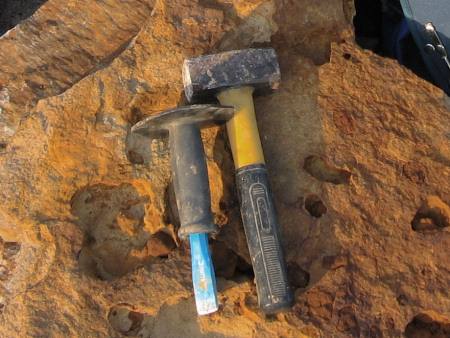
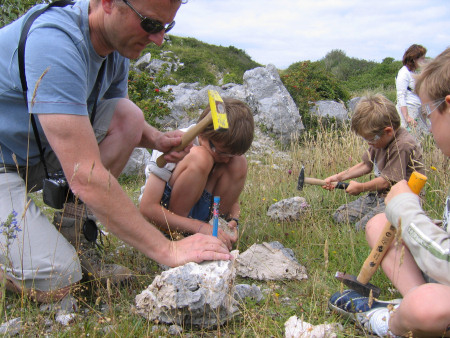
Left: A heavy
hammer and chisel including a safety handle are recommended in most
instances. Right: A group of lads hammer rocks in
a Portland quarry.
Hammer: Choosing a suitable hammer is important and will vary depending on the individual. The hammer should feature a wide head and well constructed handle. Before purchasing a hammer, try several different weights until you find one that feels comfortable. For individuals with less physical strength and children (in particular) we recommend a head weight no more than 500g; a hammer that is too heavy for the user will inhibit use and risk repetitive strain injury.
Chisel: A chisel is required for removing fossils from the surrounding matrix or splitting potential fossil bearing nodules. In most instances a large chisel should be used for completing the bulk of the work, while a smaller, more precise chisel should be used for finer work. We recommend a chisel founded from cold steel as this metal is especially engineered for hard materials; anything softer won't last five minutes. The examples (above-left) are several years old and have never been sharpened despite frequent and heavy use.
Eye protection and hammering glove
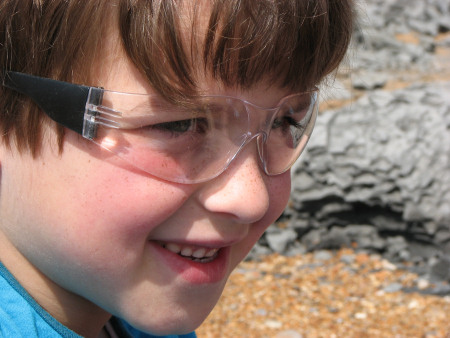
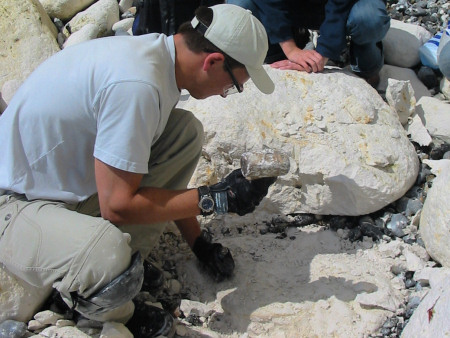
Left:
Safety glasses are essential when hammering rocks. Right:
Gloves prevent blistering while hammering.
Safety glasses: While hammering rocks there's a high risk of injury from rock splinters unless the necessary eye protection is worn. Safety glasses, as shown above, ensure any splinters are deflected away from the eyes. Eye protection should also be worn by spectators, as splinters can travel several metres from their origin.
Hammering glove: Extracting fossils from the surrounding rock can be hard work, requiring several minutes or even hours to complete in some instances. Without a protective glove the work of recovering a difficult specimen is likely to inflict numerous blisters on the individual. We recommend fingerless gloves comprised of a leather underside for grip and comfort. The example shown (above-right) is actually designed for sailing, as it needs to protect from friction burns whilst keeping the fingers free to work on deck.
Steel point and brush
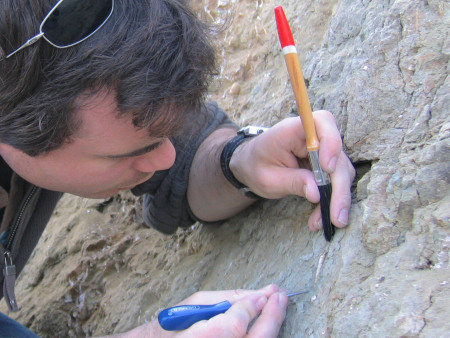
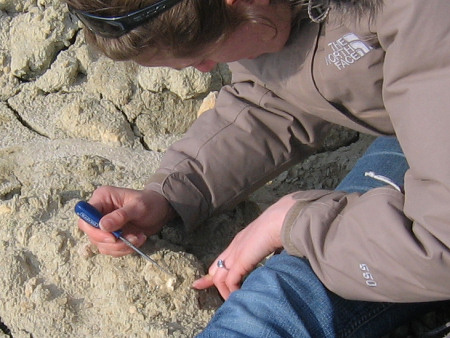
Left: Using a brush
and steel point together to extract a fragile gastropod.
Right: A steel point is often all that's needed to loosen
a fossil from the matrix.
Steel point: In some instances it's not necessary to use a hammer and chisel to remove the matrix surrounding the fossil. Sometimes all that's required is some careful precision work using a steel point. This is particularly relevant with crumbly matrix, where chiselling may otherwise shatter a fragile fossil. The steel point can also be used in conjunction with a liquid or gel glue (see below) as a last resort in the field to position and consolidate loose parts of the fossil.
Brush: A brush is an essential part of a fossil collectors toolkit, both in the field and at home. In instances where a fossil is partially covered by loose material and dust, the brush can be used to clean the surface in order to assess the most suitable method of recovery. It's also useful when making repairs in the field to clean the adjoining surfaces before gluing. We recommend a soft, fine bristled brush as pictured (above-left).
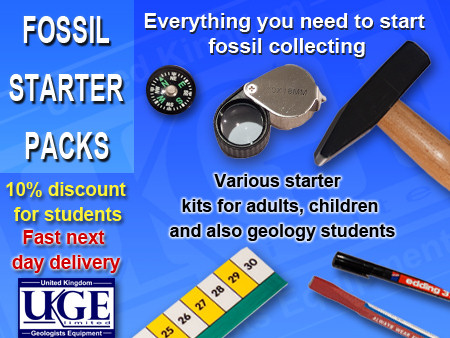

ADVERTISEMENT BY UKGE - OFFICIAL ADVERTISING PARTNER OF DISCOVERING
FOSSILS
Gel and liquid superglue
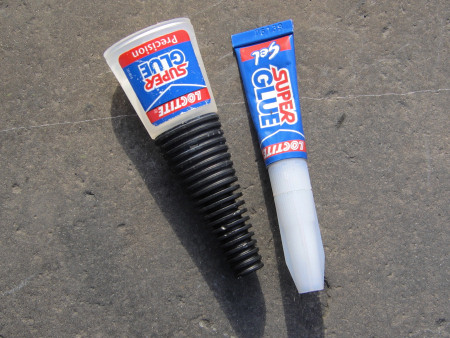
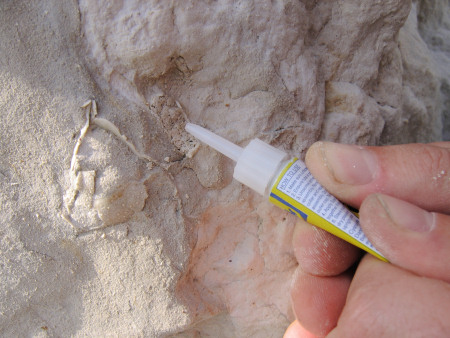
Left: Household
liquid and gel superglues should only be used as a last resort.
Right: Liquid superglue can be used to stabilise an
otherwise fragile specimen.
Superglues: Applying glue to specimens during the fossil trip should only be undertaken as a last resort, as these actions are almost certainly irreversible. For most of the time it's best to undertake repairs in a controlled place i.e. at home or under laboratory conditions. If the specimen is broken and can be safely transported without incurring further damage, a glue should not be used. In instances where the specimen would otherwise sustain irreversible damage in transit, a fast setting glue provides a practical and valuable tool.
The occasion shown above-right used a liquid superglue to solidify a chalk paste. The paste was created from a mix of local chalk and water, and inserted into the hollow echinoid shell. In this instance the solidified chalk paste ensured the safe extraction of the fossil (it would otherwise have crumbled during the attempt). Other examples have included the securing of fish scales of complete specimens recovered from shales. Without the application of a liquid superglue onsite these extremely fragile scales would disintegrate, or at best fall out of their natural positions.
Fast setting superglues are available in liquid and gel form. Liquid glues quickly penetrate cracks and the underside of loose surface material i.e. fish scales. This is particularly useful if the specimen hasn't already fallen apart; application is usually a preventative measure. Gels can be applied in a localised and controlled way, they are particularly useful if the specimen has already fallen apart and requires joining before extraction or transportation.
Please note, superglues can be potentially dangerous if handled without due care and attention. Please follow the guidelines supplied with the glue and wear safety glasses as an added safety measure.
Protective wrapping and elastic bands
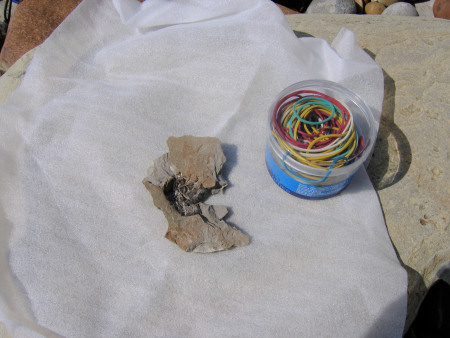
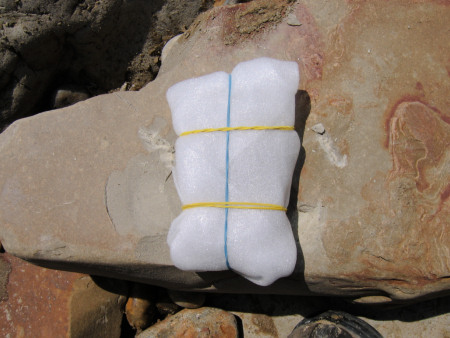
Left: Foam sheets
are an effective material for
wrapping specimens. Right: Elastic bands
prevent the foam unravelling and can be reused, unlike sticky tape.
Foam wrap: Having experimented with various materials to protect fossils during transportation and storage, we find the use of foam sheets to be the most effective. Foam sheets are commonly found in fruit boxes to prevent bruising to apples and pears etc; they work just as well at protecting fossils. The foam is light weight and easily carried during fossil trips, and can be utilised quickly and easily when needed. Unlike newspaper, foam sheets can be used a dozen or more times.
Elastic bands: When wrapping fossils with foam sheets an elastic band (or several) will prevent it unwrapping during transport. You're also likely to encounter inquisitive walkers/visitors or fellow fossil hunters interested in seeing your finds; it's much less complicated to unwrap the fossil if it's been secured with elastic bands! Elastic bands also have the added benefit that they can be used in all weather conditions.
Padded compartment box and small bags
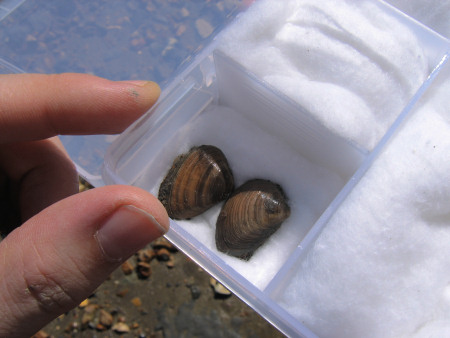
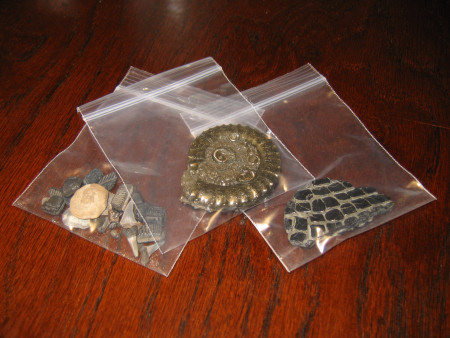
Left: A plastic compartment
box with cotton wool for padding. Right: Small sealable
plastic bags can be used independently or with the compartment box.
Padded compartment box: For small, fragile specimens it's a good idea to carry a small compartment box containing cotton wool. The addition of cotton wool ensures the specimens are held in place during transportation, without this they'd be at heighted risk of damage. It's worth noting that while cotton wool can be a benefit, in some instances it may also pose a risk to the specimen. Some specimens with fragile surface details may be susceptible to damage during the removal of strands of cotton wool that becomes caught, extra care should be taken if this occurs. The use of small plastic bags can be an added benefit for extra fragile specimens.
Small plastic bags: The use of small sealable bags is especially beneficial for isolating specimens from each other and reducing the risk of damage. For fragile specimens a bag ensures any loose fragments are contained and can be reaffixed at home or within the laboratory. As described above, a bag can be used in conjunction with cotton wool within a compartment box to prevent any stands of cotton fibre become tangled around the specimen.
Other useful items
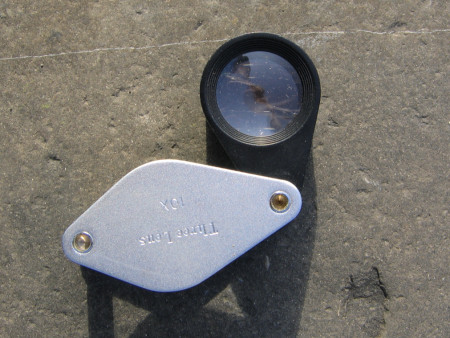
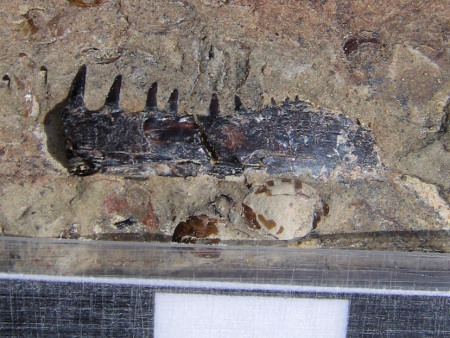
Left: A small hand lens is
useful for observing the finer details of specimens in the field and at
home. Right: A scale of some sort is useful when taking
photos.
Hand lens: A hand lens enables the fossil hunter to enjoy the finer details of the specimens they find. It's often remarkable how well preserved some of the most intricate structures can be. We recommend a lens with x10 magnification that folds away into a metal casing to protect it from damage.
Scale: When photographing fossils in situ or at home, it's recommended to include a common object for scale. Traditionally a black and white, laminated cm scale (above-right) is used. For informal purposes your hand, a hammer, chisel, mobile phone or any other commonly recognised object can be used. This will help experts identify your finds when sending images electronically.
Join us on a fossil hunt
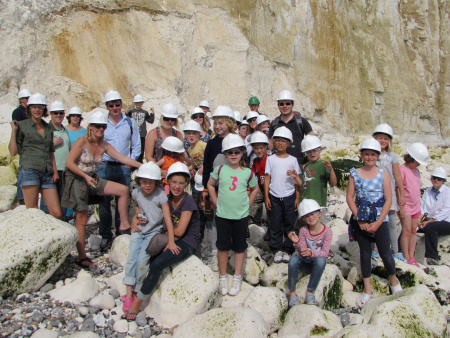
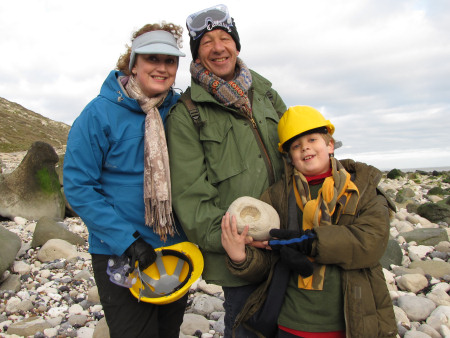
Left: A birthday party with
a twist - fossil hunting at
Peacehaven.
Right: A family hold their prized ammonite at Beachy Head.
Discovering Fossils guided fossil hunts reveal evidence of life that existed millions of years ago. Whether it's your first time fossil hunting or you're looking to expand your subject knowledge, our fossil hunts provide an enjoyable and educational experience for all. To find out more CLICK HERE


